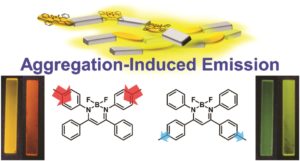The development of “element-block polymers” (defined as a minimum functional unit composed of heteroatoms) and the exploration of controlled methods for their electronic properties is crucial to design new tactics for advanced optical materials. Chujo, Tanaka and co-workers significantly contributed to this direction by developing a new concept for controlling the solid-state luminescence properties of polymers without changing the chemical components. This was achieved by synthesizing a series of alternative copolymers composed of boron diiminate with variable connection points to the comonomer units. The optical measurements revealed that the polymers possessed aggregation-induced emission (AIE) properties originating from boron diiminate. Importantly, the emission colour was varied from green to orange by altering the connection points in the film samples. Careful mechanistic studies suggested that the electron-donating and accepting abilities of the boron diiminate unit can be switched by selecting the connection points. As a result, the chain transfer character in the emission properties of the polymers was changed. Further theoretical investigations proposed that boron diiminate acts as a strong electron-acceptor in the excited state when the comonomers were connected to either one or both of the phenyl groups on the nitrogen atoms. On the contrary, when the comonomers were linked at the phenyl groups on the carbon atoms, a much weaker electron-donating property was induced. These findings pave the way for the design of advanced polymeric materials with precision function tunability without changing the chemical components.
Tips/comments directly from the authors:
- Conventional conjugated polymers can show emission only in solution, meanwhile these polymers can present intense emission even in the film. Solid-state luminescent properties were originated from AIE ability of the boron complex.
- Usually, drastic changes in chemical structures are essential for colour regulation of conjugated polymers. In this boron complex, originating from significant localization of highest occupied molecular orbitals in the boron complex, optical properties can be readily modulated by altering connecting points. Therefore, various types of luminescent materials can be obtained with the same chemical components.
- The monomers and polymers can be obtained through the several synthetic steps without special techniques. The intermediates and products showed high stability under ambient conditions. The purification for the polymers was simply performed with re-precipitation, and pure materials having good film-formability were successfully obtained.
Luminescent color tuning with polymer films composed of boron diiminate conjugated copolymers by changing the connection points to comonomers, Polym. Chem., 2018, 9, 1942-1946, DOI: 10.1039/C8PY00283E
This paper is free to read until 30 May
About the web writer
 Dr. Athina Anastasaki is a Web Writer for Polymer Chemistry. She is currently a Global Marie Curie Fellow working alongside Professor Craig Hawker at the University of California, Santa Barbara (UCSB). Please, visit this link for more information.
Dr. Athina Anastasaki is a Web Writer for Polymer Chemistry. She is currently a Global Marie Curie Fellow working alongside Professor Craig Hawker at the University of California, Santa Barbara (UCSB). Please, visit this link for more information.











